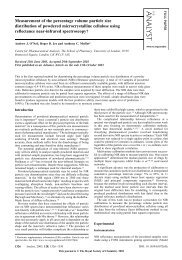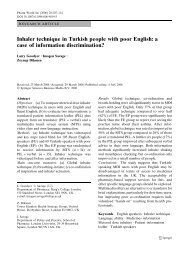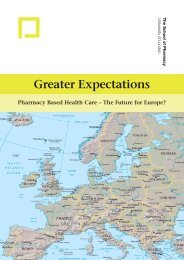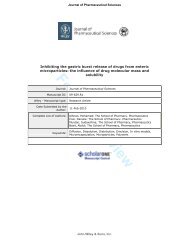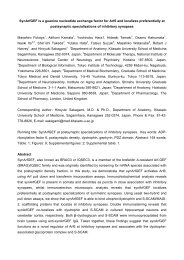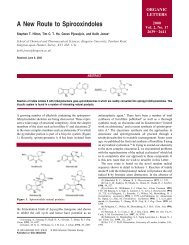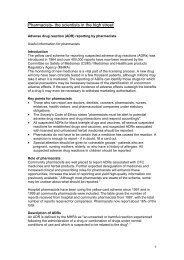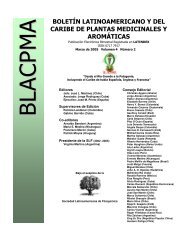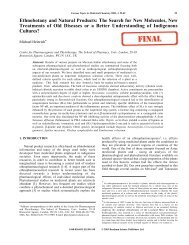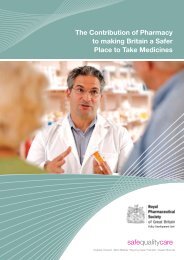Quantification of paracetamol in intact tablets ... - Pharmacy Eprints
Quantification of paracetamol in intact tablets ... - Pharmacy Eprints
Quantification of paracetamol in intact tablets ... - Pharmacy Eprints
You also want an ePaper? Increase the reach of your titles
YUMPU automatically turns print PDFs into web optimized ePapers that Google loves.
<strong>Quantification</strong> <strong>of</strong> <strong>paracetamol</strong> <strong>in</strong> <strong>in</strong>tact <strong>tablets</strong> us<strong>in</strong>g<br />
near-<strong>in</strong>frared transmittance spectroscopy<br />
Alba Eustaquio, a Paul Graham, b Roger D. Jee,* c Anthony C. M<strong>of</strong>fatt c and Andrew D.<br />
Trafford c<br />
a Department <strong>of</strong> Chemistry, Analytical Unit, University Autonoma <strong>of</strong> Barcelona, 08193<br />
Bellaterra, Barcelona, Spa<strong>in</strong><br />
b San<strong>of</strong>i Research Divison, Alnwick Research Centre, Willowburn Avenue, Alnwick,<br />
UK NE66 2JH<br />
c Centre for Pharmaceutical Analysis, School <strong>of</strong> <strong>Pharmacy</strong>, University <strong>of</strong> London, 29–39<br />
Brunswick Square, London, UK WC1N 1AX<br />
Received 15th June 1998, Accepted 4th September 1998<br />
Production batch samples <strong>of</strong> <strong>paracetamol</strong> <strong>tablets</strong> and specially prepared out-<strong>of</strong>-specification batches cover<strong>in</strong>g the<br />
range 90–110% <strong>of</strong> the stated amount (500 mg) were analysed by the BP <strong>of</strong>ficial UV assay and by NIR<br />
transmittance spectroscopy. NIR measurements were made on 20 <strong>in</strong>tact <strong>tablets</strong> from each batch, scanned five<br />
times each (10 m<strong>in</strong> measurement time per batch) over the spectral range 6000–11 520 cm 21. An average spectrum<br />
was calculated for each batch. Partial least squares (PLS) regression models were set up us<strong>in</strong>g a calibration set (20<br />
batches) between the NIR response and the reference tablet <strong>paracetamol</strong> content (UV). Various pre-treatments <strong>of</strong><br />
the spectra were exam<strong>in</strong>ed; the smallest relative standard error <strong>of</strong> prediction (0.73%) was obta<strong>in</strong>ed us<strong>in</strong>g the first<br />
derivative <strong>of</strong> the absorbance over the full spectrum. Only two pr<strong>in</strong>cipal components were required for the PLS<br />
model to give a good relationship between the spectral <strong>in</strong>formation and <strong>paracetamol</strong> content. Apply<strong>in</strong>g this model<br />
to the validation set (15 batches) gave a mean bias <strong>of</strong> 20.08% and a mean accuracy <strong>of</strong> 0.59% with relative<br />
standard deviations <strong>of</strong> 0.75 and 0.44%, respectively. The proposed method is non-destructive and therefore lends<br />
itself to on-l<strong>in</strong>e/at-l<strong>in</strong>e production control purposes. The method is easy to use and does not require a knowledge<br />
<strong>of</strong> the mass <strong>of</strong> the <strong>tablets</strong>.<br />
The use <strong>of</strong> near-<strong>in</strong>frared (NIR) spectroscopy has grown<br />
dramatically over the past two decades, chiefly ow<strong>in</strong>g to the<br />
advances <strong>in</strong> the robustness and ease <strong>of</strong> use <strong>of</strong> the <strong>in</strong>strumentation<br />
and the availability <strong>of</strong> high quality chemometrics with<br />
which to process the data. In addition, NIR spectroscopy can<br />
<strong>of</strong>ten be used to analyse samples directly without the need for<br />
any preparation. These attributes have made the technique well<br />
suited for production control purposes for many different<br />
products, <strong>in</strong>clud<strong>in</strong>g foodstuffs, 1 textiles, 2 polymers 3 and pharmaceuticals.<br />
4<br />
As early as 1968, Sherken 5 <strong>of</strong> the US Food and Drugs<br />
Adm<strong>in</strong>istration reported the use <strong>of</strong> an NIR based assay for<br />
meprobamate <strong>in</strong> tablet mixtures and commercially available<br />
preparations, but it <strong>in</strong>volved gr<strong>in</strong>d<strong>in</strong>g the <strong>tablets</strong> before analysis.<br />
The accuracy <strong>of</strong> the NIR method was comparable to that <strong>of</strong> the<br />
<strong>of</strong>ficial National Formulary method.<br />
S<strong>in</strong>ce then, NIR spectroscopy has been grow<strong>in</strong>g <strong>in</strong> use <strong>in</strong> the<br />
pharmaceutical <strong>in</strong>dustry both on the production floor and <strong>in</strong> the<br />
laboratory and has been used for the analysis <strong>of</strong> powder blends,<br />
granules and milled <strong>tablets</strong>. 6 A large step forward was the<br />
development <strong>of</strong> methods to analyse solid dosage formulations<br />
without gr<strong>in</strong>d<strong>in</strong>g or extraction, and <strong>in</strong> 1987 Lodder et al. 7<br />
analysed adulterated and unadulterated capsules us<strong>in</strong>g NIR<br />
spectroscopy directly. More recently, the identification <strong>of</strong> active<br />
drugs <strong>in</strong> <strong>tablets</strong> has been reported. 8 The potential for on-l<strong>in</strong>e or<br />
at-l<strong>in</strong>e identification, qualification and quantification <strong>of</strong> the<br />
f<strong>in</strong>al dosage form therefore became a reality.<br />
As the use <strong>of</strong> NIR spectroscopy grew, the importance <strong>of</strong><br />
sample presentation was recognised, particularly <strong>in</strong> the position<strong>in</strong>g<br />
<strong>of</strong> the dosage form <strong>in</strong> the spectrometer. Specially constructed<br />
reflective alum<strong>in</strong>ium sample cells, designed for capsules 7 or<br />
<strong>tablets</strong>, 9 appeared for use <strong>in</strong> reflectance spectroscopy.<br />
The use <strong>of</strong> transmittance measurements has brought the<br />
advantage over reflectance NIR spectroscopic measurements<br />
that it is less sensitive to the <strong>in</strong>homogeneity <strong>of</strong> the material,<br />
which is a problem <strong>in</strong> reflectance analyses. 10 Work <strong>in</strong> this mode<br />
<strong>of</strong> NIR spectroscopy has been slow to develop, but the new<br />
generation <strong>of</strong> transmittance <strong>in</strong>struments that have become<br />
available recently <strong>of</strong>fer the potential for greater accuracy than<br />
with conventional reflectance <strong>in</strong>struments.<br />
Process<strong>in</strong>g NIR data can be carried out <strong>in</strong> a number <strong>of</strong> ways<br />
to simplify the spectral <strong>in</strong>formation. One transformation <strong>of</strong> the<br />
data is by us<strong>in</strong>g pr<strong>in</strong>cipal component analysis, which decreases<br />
the problems created by sources <strong>of</strong> spectral noise and by the<br />
highly correlated nature <strong>of</strong> NIR wavelength data. 11 Transformation<br />
<strong>of</strong> the spectral data to pr<strong>in</strong>cipal axes simplifies the selection<br />
<strong>of</strong> variables for regression models and permits variables to be<br />
added or deleted from the regression equation without chang<strong>in</strong>g<br />
the coefficients <strong>of</strong> the rema<strong>in</strong><strong>in</strong>g variables. One method for<br />
quantitative analysis based on this mathematical transformation<br />
is partial least squares (PLS) regression. This attempts to<br />
expla<strong>in</strong> as much <strong>of</strong> the observed variation <strong>in</strong> the dependent<br />
variables as possible us<strong>in</strong>g the m<strong>in</strong>imum <strong>of</strong> relevant factors<br />
conta<strong>in</strong>ed <strong>in</strong> the spectral data. 12<br />
The recent appearance on the market <strong>of</strong> a commercial semiautomatic<br />
NIR transmittance spectrometer specifically designed<br />
for the analysis <strong>of</strong> <strong>in</strong>tact <strong>tablets</strong> led us to try it for the<br />
quantification <strong>of</strong> <strong>paracetamol</strong> <strong>in</strong> <strong>tablets</strong> as a model example.<br />
PLS was used to treat the spectral data for the reasons given<br />
above.<br />
Analyst, 1998, 123, 2303–2306 2303
Experimental<br />
Reagents and samples<br />
All reagents were <strong>of</strong> analytical-reagent grade and were obta<strong>in</strong>ed<br />
from BDH (Poole, Dorset, UK).<br />
Forty-five batches <strong>of</strong> <strong>paracetamol</strong> <strong>tablets</strong> were used for the<br />
study, <strong>of</strong> which 35 were normal production batches <strong>of</strong> Sterw<strong>in</strong><br />
500 mg <strong>paracetamol</strong> <strong>tablets</strong> (nom<strong>in</strong>al content 84.175% m/m<br />
<strong>paracetamol</strong>) with a nom<strong>in</strong>al diameter <strong>of</strong> 12.7 mm and thickness<br />
<strong>of</strong> 3.80 to 4.15 mm and 10 were development batches (76–92%<br />
m/m <strong>paracetamol</strong>, i.e. 90–110% <strong>of</strong> the nom<strong>in</strong>al label content).<br />
The development batches were <strong>of</strong> the same dimensions as the<br />
normal production samples but were specially manufactured for<br />
this study at a pilot scale on a small press, by alter<strong>in</strong>g the content<br />
<strong>of</strong> <strong>paracetamol</strong> and the major excipient (starch).<br />
Apparatus<br />
NIR spectroscopy. Transmittance spectra were measured<br />
us<strong>in</strong>g a NIRTAB system (Buhler, Anatec, Uzwill, Switzerland)<br />
designed for tablet analysis. It consisted <strong>of</strong> a NIRTAB FT-NIR<br />
spectrometer and autosampler unit l<strong>in</strong>ked by an optical fibre<br />
connection. The autosampler had an adjustable multi-layer plate<br />
system with holes around its periphery to take up to 40 samples<br />
<strong>of</strong> vary<strong>in</strong>g sizes, which ensured that each sample was<br />
reproducibly located central to the light beam. NIRCAL<br />
s<strong>of</strong>tware version 2.0 (Buhler, Anatec) was used to control the<br />
system and process the data. Spectra were also transferred from<br />
NIRCAL to Excel (Micros<strong>of</strong>t Excel V7.0a) for some data<br />
transformations.<br />
UV spectrophotometry. A Lambda 15 UV/VIS spectrophotometer<br />
(Perk<strong>in</strong>-Elmer, Beaconsfield, Buck<strong>in</strong>ghamshire, UK)<br />
was used for the UV assay <strong>of</strong> the <strong>tablets</strong>.<br />
Analytical procedures<br />
NIR measurements. The <strong>paracetamol</strong> <strong>tablets</strong> were placed on<br />
the adjustable plate system <strong>of</strong> the autosampler and the diameter<br />
<strong>of</strong> the holes <strong>in</strong> the plate system was adjusted to centralise the<br />
<strong>tablets</strong> and ensure that there was no stray light dur<strong>in</strong>g<br />
measurement. Tablets were always placed with the same face up<br />
and their transmittance spectra measured automatically us<strong>in</strong>g a<br />
macro <strong>in</strong> the NIRCAL s<strong>of</strong>tware. The measurement time for each<br />
tablet was 3 s per scan and the <strong>in</strong>strument was operated at a<br />
resolution <strong>of</strong> 12 cm 21 between 6000 and 11 520 cm 21.<br />
Normally 20 <strong>tablets</strong> from each <strong>of</strong> the batches were measured<br />
us<strong>in</strong>g five scans for each tablet and a mean spectrum for the<br />
batch was calculated from these 100 spectra. A sample <strong>of</strong><br />
Spectralon (5 mm thick) was used as the reference before<br />
scann<strong>in</strong>g <strong>of</strong> each batch. The method allowed the measurement<br />
<strong>of</strong> a production batch <strong>in</strong> about 10 m<strong>in</strong> by us<strong>in</strong>g the programmable<br />
autosampler.<br />
UV measurements. The UV assay used as the reference<br />
method to quantify <strong>paracetamol</strong> <strong>in</strong> the <strong>tablets</strong> was that <strong>of</strong> the<br />
British Pharmacopoeia 1993. 13<br />
Results and discussion<br />
Selection <strong>of</strong> number <strong>of</strong> scans<br />
Prelim<strong>in</strong>ary experiments were conducted to f<strong>in</strong>d the optimum<br />
number <strong>of</strong> scans for each tablet. Fig. 1 shows the results <strong>of</strong><br />
measur<strong>in</strong>g four sets <strong>of</strong> 20 <strong>tablets</strong> (all from the same batch) us<strong>in</strong>g<br />
2304 Analyst, 1998, 123, 2303–2306<br />
1, 5, 10 and 20 scans to calculate the mean spectrum. The mean<br />
spectrum obta<strong>in</strong>ed us<strong>in</strong>g only one scan per tablet is too noisy<br />
(although it is the mean <strong>of</strong> 20 s<strong>in</strong>gle tablet spectra) for<br />
quantitative work; however, us<strong>in</strong>g 5, 10 or 20 scans per tablet<br />
gave acceptable spectra. Five scans were chosen as the optimum<br />
to obta<strong>in</strong> a smooth spectrum <strong>in</strong> as short a time as possible, so<br />
limit<strong>in</strong>g the exposure <strong>of</strong> the <strong>tablets</strong> to NIR radiation, which<br />
might cause thermal degradation.<br />
Mean NIR transmission spectra for the <strong>paracetamol</strong> batches<br />
<strong>of</strong> 90 and 110% <strong>of</strong> the stated amount are shown <strong>in</strong> Fig. 2.<br />
Compensation for different tablet mass<br />
S<strong>in</strong>ce the NIR absorption by a tablet is both content and<br />
pathlength dependent, the effect <strong>of</strong> different tablet masses and<br />
heights was <strong>in</strong>vestigated. The diameter <strong>of</strong> the <strong>tablets</strong> for a given<br />
batch is effectively fixed by the punch and dies used. Twenty<br />
<strong>tablets</strong> from the same batch were weighed and the heights<br />
measured with a micrometer to establish the relationship<br />
between the height and mass <strong>of</strong> the <strong>tablets</strong> (Fig. 3). The<br />
relationships between absorbance (at 9300 cm 21) and tablet<br />
height and mass are given <strong>in</strong> Fig. 4 and 5, respectively. For<br />
<strong>in</strong>dividual tablet measurements it would therefore be sufficient<br />
simply to measure the mass <strong>of</strong> each tablet and use it to allow for<br />
variations <strong>in</strong> tablet thickness.<br />
In this work it was decided to use the mean spectrum from 20<br />
<strong>tablets</strong> to remove most <strong>of</strong> the differences between <strong>in</strong>dividual<br />
<strong>tablets</strong>. However, spectral corrections were considered when<br />
develop<strong>in</strong>g the PLS model (see below) to take <strong>in</strong>to account<br />
batch variations by us<strong>in</strong>g<br />
Fig. 1 Part <strong>of</strong> the mean NIR transmittance spectra for 20 <strong>tablets</strong> us<strong>in</strong>g<br />
different numbers <strong>of</strong> scans: (a) 1; (b) 5; (c) 10; and (d) 20 scans.<br />
Fig. 2 Mean NIR transmittance spectra for <strong>paracetamol</strong> <strong>tablets</strong> (500 mg):<br />
(a) 90% <strong>of</strong> stated amount; and (b) 110% <strong>of</strong> stated amount.
S S m<br />
* =<br />
m<br />
(1)<br />
t<br />
where S* is the mass corrected spectrum, S the orig<strong>in</strong>al<br />
spectrum, m the mean tablet mass <strong>of</strong> 20 <strong>tablets</strong> for the batch, and<br />
mt the theoretical tablet mass for production. The correction<br />
factor was applied to each spectral data po<strong>in</strong>t across the whole<br />
spectrum.<br />
Construction <strong>of</strong> the PLS models<br />
The 35 batches <strong>of</strong> <strong>paracetamol</strong> <strong>tablets</strong> were divided <strong>in</strong>to two<br />
sets: calibration and validation sets. The calibration set was used<br />
to construct the PLS regression and comprised 20 batches that<br />
gave a good spread <strong>of</strong> values from 90 to 110% <strong>of</strong> the stated<br />
amount. It <strong>in</strong>cluded both production batches and the specially<br />
Fig. 3 Relationship between tablet mass and tablet height for <strong>paracetamol</strong><br />
<strong>tablets</strong>. All <strong>tablets</strong> from the same batch.<br />
Fig. 4 Relationship between NIR absorbance (at 9300 cm 21 ) and tablet<br />
height for <strong>paracetamol</strong> <strong>tablets</strong>. All <strong>tablets</strong> from the same batch.<br />
Fig. 5 Relationship between NIR absorbance (at 9300 cm 21) and tablet<br />
mass for <strong>paracetamol</strong> <strong>tablets</strong>. All <strong>tablets</strong> from the same batch.<br />
produced batches to give the largest variation <strong>in</strong> <strong>paracetamol</strong><br />
content and types <strong>of</strong> <strong>tablets</strong> expected <strong>in</strong> practice.<br />
The validation set was used to evaluate the prediction<br />
capability <strong>of</strong> the PLS model constructed from the calibration<br />
set. Fifteen batches that were not used <strong>in</strong> the calibration set, and<br />
lay between 95 and 105% <strong>of</strong> the stated amount, were used <strong>in</strong> this<br />
set.<br />
PLS regression models were calculated us<strong>in</strong>g centred data<br />
and the number <strong>of</strong> PLS pr<strong>in</strong>cipal components used was selected<br />
to give the m<strong>in</strong>imum residual error sum squares for the<br />
validation set. To compare the results from all the different<br />
models constructed, the relative standard error <strong>of</strong> prediction<br />
(RSEP) was used:<br />
RSEP (%) =<br />
n<br />
Â<br />
i = 1<br />
( C - C )<br />
n<br />
Â<br />
i = 1<br />
UV NIR<br />
C<br />
2<br />
UV<br />
2<br />
¥ 100 (2)<br />
Where C is the percentage <strong>paracetamol</strong> content as measured by<br />
the UV (reference) and NIR methods and n the number <strong>of</strong><br />
samples. The RSEP value gives an estimation <strong>of</strong> the mean<br />
percentage error for each set and the results for all the models<br />
constructed are given <strong>in</strong> Table 1.<br />
Three different spectral ranges were used, viz. the full<br />
spectrum (6000–11 520 cm 21) and the ranges 7692–8400 cm 21<br />
and 9096–11 520 cm 21 where the spectra showed the maximum<br />
differences due to <strong>paracetamol</strong> content (Fig. 2). The results<br />
obta<strong>in</strong>ed us<strong>in</strong>g the two restricted spectral ranges did not show<br />
any significant differences from or advantages over us<strong>in</strong>g the<br />
full spectrum, which generally gave the smaller error <strong>of</strong><br />
prediction. Us<strong>in</strong>g the full spectrum also had the advantage that<br />
small spectral variations have a m<strong>in</strong>imal effect on the<br />
quantification.<br />
In an attempt to improve the predictive capacity <strong>of</strong> the<br />
spectral <strong>in</strong>formation, various pretreatments were tried before<br />
the PLS model was constructed (Table 1). These spectral<br />
pretreatments were available us<strong>in</strong>g the NIRCAL s<strong>of</strong>tware and<br />
Table 1 Relative standard error <strong>of</strong> prediction (RSEP) for different PLS<br />
models<br />
Spectral range<br />
6000– 7692– 9096–<br />
11 520 cm 21 8400 cm 21 11 520 cm 21<br />
Pre-treatment a Cal. b Pred. c Cal. Pred. Cal. Pred.<br />
Transmittance 0.70 d 0.88 0.66 d 0.95 0.64 d 0.86<br />
Transmittance-m 0.65 d 0.84 0.67 d 0.97 0.64 d 0.84<br />
Absorbance 0.78 e 0.80 0.71 d 0.84 0.79 e 0.81<br />
Absorbance-m 0.71 d 0.79 0.62 d 0.85 0.79 d 0.79<br />
Absorbance-D1 0.31 e 0.73 0.53 e 0.94 0.78 e 0.77<br />
Absorbance-D1-m 0.33 e 0.75 0.53 e 0.91 0.80 e 0.74<br />
Absorbance-D2 0.78 e 0.80 0.60 d 0.87 0.79 e 0.81<br />
Absorbance-D2-m 0.40 e 0.92 0.44 d 1.06 0.27 f 1.22<br />
Transmittance-S 0.64 d 0.86 0.68 d 0.95 0.64 d 0.86<br />
Transmittance-S-m 0.65 d 0.84 0.71 d 0.97 0.65 d 0.84<br />
Absorbance-S 0.78 e 0.80 0.63 d 0.88 0.77 d 0.81<br />
Absorbance-S-m 0.72 d 0.79 0.65 d 0.86 0.79 d 0.80<br />
Transmittance-MSC 0.71 e 0.75 — — — —<br />
Transmittance-MSC-m 0.71 e 0.75 — — — —<br />
Absorbance-MSC 0.77 e 0.75 — — — —<br />
Absorbance-MSC-m 0.81 d 0.73 — — — —<br />
a m = Spectra corrected for mass; D1 = first-derivative spectra;<br />
D2 = second-derivative spectra; S = Savitzky–Golay smooth<strong>in</strong>g <strong>of</strong> spectra;<br />
MSC = multiplicative scatter correction. b Calibration data set. c Prediction<br />
data set. e PLS model us<strong>in</strong>g three PLS pr<strong>in</strong>cipal components. f PLS model<br />
us<strong>in</strong>g two pr<strong>in</strong>cipal components; f PLS model us<strong>in</strong>g four pr<strong>in</strong>ciple<br />
components.<br />
Analyst, 1998, 123, 2303–2306 2305
were transmittance (T), absorbance [log (1/T)], first and second<br />
derivatives <strong>of</strong> absorbance (Savitzky–Golay, n<strong>in</strong>e po<strong>in</strong>ts, cubic<br />
polynomial), smooth<strong>in</strong>g (Savitzky–Golay, n<strong>in</strong>e po<strong>in</strong>ts, cubic<br />
polynomial) <strong>of</strong> both transmittance and absorbance and multiplicative<br />
scatter correction (us<strong>in</strong>g the full spectral range). In<br />
addition, spectra were also corrected for the mass <strong>of</strong> the <strong>tablets</strong><br />
(see above). First and second derivatives <strong>of</strong> the transmittance<br />
spectra were not used s<strong>in</strong>ce the transformed data exhibited<br />
excessive noise.<br />
Selection <strong>of</strong> the best model<br />
There were no large differences between any <strong>of</strong> the pretreatments<br />
and almost all <strong>of</strong> them give an error <strong>of</strong> less than 1%<br />
(Table 1). That the PLS models only used two or three<br />
components meant that there was a good relationship between<br />
the spectral <strong>in</strong>formation and <strong>paracetamol</strong> content. Correct<strong>in</strong>g<br />
for the mass <strong>of</strong> the <strong>tablets</strong> did not appear to improve the<br />
accuracy; presumably tak<strong>in</strong>g the mean spectrum for 20 <strong>tablets</strong><br />
<strong>in</strong> a batch effectively removes physical variability between<br />
<strong>in</strong>dividual <strong>tablets</strong>.<br />
The best results were obta<strong>in</strong>ed us<strong>in</strong>g the first derivative <strong>of</strong> the<br />
absorbance spectrum or the absorbance spectrum after correction<br />
for multiplicative scatter and tablet mass. Both gave an<br />
RSEP <strong>of</strong> 0.73% for the validation set. However, the former is<br />
more robust and does not require weigh<strong>in</strong>g the <strong>tablets</strong>, and<br />
consequently was the preferred quantification model.<br />
<strong>Quantification</strong> <strong>of</strong> <strong>paracetamol</strong> <strong>tablets</strong><br />
Us<strong>in</strong>g the first derivative <strong>of</strong> NIR absorbance and a two pr<strong>in</strong>cipal<br />
component PLS model, the amount <strong>of</strong> <strong>paracetamol</strong> <strong>in</strong> the 35<br />
batches <strong>of</strong> <strong>tablets</strong> was calculated and compared with the results<br />
from the UV assay (Table 2). The percentage error was low with<br />
a maximum value <strong>of</strong> 21.18%. The bias and accuracy (with<br />
respect to the UV value) for the validation batches (n = 15)<br />
were calculated us<strong>in</strong>g<br />
È n<br />
˘<br />
( NIR value - UV value)<br />
Mean bias (%) = Í<br />
¥ 100 ˙ / n<br />
Í UV value<br />
˙<br />
(3)<br />
ÎÍ<br />
=Âi 1<br />
˚˙<br />
Mean accuracy (%) =<br />
È n<br />
˘<br />
Í NIR value - UV value<br />
¥ 100˙<br />
/ n<br />
Í UV value<br />
˙<br />
(4)<br />
ÎÍ<br />
=Âi 1<br />
˚˙<br />
The mean bias was 20.08% and the mean accuracy was 0.59%<br />
with standard deviations <strong>of</strong> 0.75 and 0.44%, respectively.<br />
Conclusions<br />
NIR spectroscopy has been shown to be a viable alternative to<br />
UV spectrophotometry for the assay <strong>of</strong> <strong>paracetamol</strong> <strong>in</strong> <strong>paracetamol</strong><br />
<strong>tablets</strong> and it takes only 20 m<strong>in</strong> to analyse a batch once<br />
the calibration model has been set up. The proposed firstderivative<br />
absorption model is easy to use and does not need a<br />
knowledge <strong>of</strong> the mass <strong>of</strong> the <strong>tablets</strong>. It is a non-destructive<br />
method and thus lends itself very well for on-l<strong>in</strong>e/at-l<strong>in</strong>e<br />
production control purposes.<br />
We thank Mr. Keith Longdon and Buhler for the loan <strong>of</strong><br />
NIRTAB and NIRCAL. Andrew Trafford thanks San<strong>of</strong>i Lilly<br />
and Bristol-Myers Squibb for a Research Studentship. Alba<br />
Eustaquio acknowledges the M<strong>in</strong>istry <strong>of</strong> Education and<br />
Sciences, Spa<strong>in</strong>, for the award <strong>of</strong> an FPI grant.<br />
2306 Analyst, 1998, 123, 2303–2306<br />
Table 2 Comparison <strong>of</strong> the <strong>paracetamol</strong> content as determ<strong>in</strong>ed us<strong>in</strong>g the<br />
UV reference method and NIR spectroscopy (two pr<strong>in</strong>cipal component PLS<br />
model us<strong>in</strong>g first-derivative absorbance)<br />
References<br />
Paracetamol (% <strong>of</strong> stated amount)<br />
Sample a UV assay NIR assay Error (%)<br />
1c 90.73 90.45 20.31<br />
2c 92.65 92.33 20.35<br />
3 95.37 94.49 20.92<br />
4c 97.63 97.25 20.39<br />
5c 99.20 99.59 0.39<br />
6 99.72 100.14 0.42<br />
7c 99.85 100.28 0.43<br />
8c 99.88 100.18 0.30<br />
9 99.88 100.08 0.20<br />
10c 99.97 100.68 0.71<br />
11 100.02 101.11 1.09<br />
12c 100.03 100.37 0.34<br />
13 100.07 100.14 0.07<br />
14c 100.17 100.29 0.12<br />
15 100.20 100.35 0.15<br />
16c 100.21 100.37 0.16<br />
17 100.26 100.50 0.24<br />
18c 100.27 100.34 0.07<br />
19 100.33 101.39 1.06<br />
20c 100.41 100.41 0.00<br />
21 100.61 101.11 0.50<br />
22c 100.73 100.77 0.04<br />
23 100.87 100.09 20.77<br />
24c 101.02 100.85 20.17<br />
25 101.06 100.10 20.95<br />
26c 101.09 101.16 0.07<br />
27 101.11 101.21 0.10<br />
28 101.57 100.37 21.18<br />
29c 101.74 101.72 20.02<br />
30 101.78 100.62 21.14<br />
31c 101.88 101.44 20.43<br />
32c 102.27 102.12 20.15<br />
33 105.17 105.11 20.06<br />
34c 107.87 106.97 20.83<br />
35c 110.23 110.28 0.05<br />
a c, Calibration set; other samples, validation set.<br />
1 B. G. Osborne, T. Fearn and P. H. H<strong>in</strong>dle, Practical NIR<br />
Spectroscopy with Applications <strong>in</strong> Food and Beverage Analysis,<br />
Longman, Harlow, 1986.<br />
2 M. Blanco, J. Coello, H. Iturriaga, S. Maspoch and E. Bertran,<br />
Analyst, 1994, 119, 1779.<br />
3 K. A. Bund<strong>in</strong>g Lee, Appl. Spectrosc. Rev., 1993, 28, 231.<br />
4 J. K. Drennen and R. A. Lodder, <strong>in</strong> Advances <strong>in</strong> Near-Infrared<br />
Measurements, ed. G. Patonay, Jai Press, Greenwich, CT, 1993, vol.<br />
1, pp. 93–112.<br />
5 S. Sherken, J. Assoc. Off. Anal. Chem., 1968, 51, 616.<br />
6 J. D. Kirsch and J. K. Drennen, Appl. Spectrosc. Rev., 1995, 30,<br />
139.<br />
7 R. A. Lodder, M. Selby and G. M. Hieftje, Anal. Chem., 1987, 59,<br />
1921.<br />
8 P. R. Khan, R. D. Jee, R. A. Watt and A. C. M<strong>of</strong>fat, Pharm. Sci., 1997,<br />
3, 447.<br />
9 R. A. Lodder and G. M. Hieftje, Appl. Spectrosc., 1988, 42, 556.<br />
10 J. Gottfries, H. Depui, M. Fransson, M. Jongeneelen, M. Josefson,<br />
F. W. Langkilde and D. T. Witte, J. Pharm. Biomed. Anal., 1996, 14,<br />
1495.<br />
11 I. A. Cowe and J. W. McNichol, Appl. Spectrosc., 1985, 39, 257.<br />
12 M. A. Sharaf, D. L. Illman and B. R. Kowalski, Chemometrics,<br />
Wiley, New York, 1986.<br />
13 British Pharmacopoeia 1993, HM Stationery Office, London, 1993,<br />
vol. II, p. 1043.<br />
Paper 8/04528C



